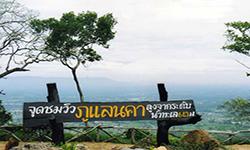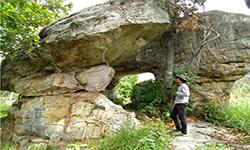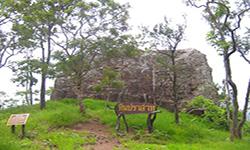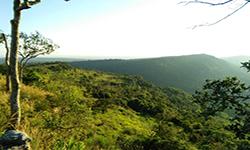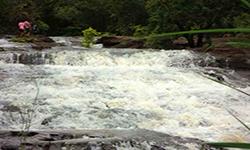Phu Laenkha National Park
Contact Location : Phu Laenkha National Park, Huai Ton Sub-district, Mueang Chaiyaphum District, Chaiyaphum Province 36000
Telephone Number : (+66) 9 3093 9193, (+66) 4410 9786
Email : Phulaenkha_dnp2@hotmail.com
Facebook : Phu Laenka National Park
Information
Phu Laenkha National Park covers the areas of Ban Han, Sa Phon Thong, Non Kok, Sap Si Thong and Ban Dua Sub-district, Kaset Sombun District, Kut Chum Saeng and Khu Mueang Sub-district, Nong Bua Daeng District, Tha Mafai Wan Sub-district, Kaeng Kho District, Huai Ton Sub-district, Mueang Chaiyaphum District, Phu Laenkha Sub-district, Ban Khwao District, Chaiyaphum Province. Forest conditions are fertile and are habitats for many species of wildlife. There are interesting natural features such as Phu Laenkha Viewpoint, Pha Kluai Mai, Hin Prasat, Pratu Khlong, Mo Hin Khao, etc.,
Background
The areas designated as a conservation forest area according to the Cabinet resolution dated 10 and 7 March 1992 were the areas in the Phu Laenkha National Reserved Forest on the north side and the Phu Laen Kha National Reserved Forest on the south side of Mueang, Ban Khwao, Nong Bua Daeng, and Kaset Sombun District, Chaiyaphum Province. According to Royal Forest Department order 2262/2539 dated December 13, 1996, Mr. Surachai, Mr. Chamroen Forestry Officer, Level 5 of the National Park Division. To the Superintendent of Tat Ton National Park to conduct an initial survey of the reserved forest in order to establish it as a national park. The forestry officers coordinated with the relevant organizations in Chaiyaphum province and due to the survey the officers also coordinated with both the public and private sectors, various organizations, people, as well as the provincial forestry agencies of Chaiyaphum Province and Nakhon Ratchasima.
Tat Ton National Park: The head of the survey and study team has submitted the survey report to the Forestry Office in Chaiyaphum Province to consider as cited in the document of Tat Ton National Park No. Ko So 0712.320/89 dated February 21, 1996, the Chaiyaphum Provincial Forestry Office considered the matter and agreed with the officer of Tat Ton National Park and proposed to the Subcommittee on Prevention of Smuggling of Forest Resources in Chaiyaphum Province for further consideration as cited in the document of the Forestry Office of Chaiyaphum Province No. Cho Yo. 0009.2/720 dated 27 June 1996.
At the meeting No. 1/2539, dated September 23, 1996, of the Subcommittee on Prevention and Suppression of Forest Resources Smuggling, considering designating some conservation forest areas of the Phu Laenkha National Reserved Forest which is in the north side and the Phu Laenkha National Reserved Forest which is in the south side, with an area of approximately 92,500 rai (148 square kilometers), to be a national park. According to a document from the National Park Division No. Ko So. 0712/special dated December 20, 2539, the subcommittee has approved and supported the Royal Forest Department to declare such conservation forest areas as a national park soon and had the same opinion in naming this new agency as "Phu Laenkha National Park" for the reason that the attractions of the new national park are located in the Phu Laenkha Mountains and are well known to the general public. Mr. Sathit Swinthorn, Director-General of the Royal Forest Department, approved the the name "Phu Laenkha National Park" on January 20, 1997.
Subsequently, in 2007, there was a royal decree specifying the land area of Phu Laenkha Forest on the northern part of and the forest on the southern part of Ban Han, Sa Phon Thong, Non Kok, Sap Si Thong, and Ban Dua Sub-district, Kaset Sombun District, Kut Chum Saeng and Khu Mueang Sub-district, Nong Bua Daeng District, tha Mafai Wan Sub-district, Kaeng Kho District, Huai Ton Sub-district, Mueang Chaiyaphum District, Phu Laenkha Sub-district, Ban Khwao District, Chaiyaphum Province, a total area of approximately 200.50 square kilometers or 125,312.50 rai, to be a national park.
It was announced in the Government Gazette, Volume 124, Part 37 Ko, dated July 27, 2007. It is classified as the 108th national park in the country.
Note : After paying the entrance fee to the National Park, please carry the receipt for inspection.
125312.50 rai (200.5 square kilometers)
|
|
|
||
|
|
|
||
|
|
|
||
-
Welfare shop : 08.00 - 17:00 hrs.
Mobile phone signal:
National Park Headquarters area: AIS, TRUE
|
|
The general characteristics of the protected forest area surveyed are part of the Phu Laenkha Mountain range, Phu Khiao, and Phu Kham Noi which are complex mountains landscape and plateaus that are an elevation ranging from about 200 to 1,038 meters above mean sea level. Yod Phu Khe is the highest peak of the area, with an elevation of approximately 1,038 meters above mean sea level. The area on the south side is a slope area which is about 200 to 700 meters above mean sea level, and the northern area is a very steep, mostly consisting of cliffs and valleys.
|
|
It is classified under a tropical rainy climate with 3 seasons, influenced by the seasonal monsoon. The average temperature is about 27.66 degrees Celsius, the average relative humidity for the year is 60 %, and the average rainfall for the year is 1,155.36.
|
|
|
|
|
Plant characteristics : Due to the fact that the Phu Langka Mountain range is located at an altitude of about 300-1000 meters above mean sea level, therefore 4 types of forest conditions are formed as follows. 1. A mixed deciduous forest is generally found on the cliffs in the northern part of the area at an altitude of about 300 - 800 meters above mean sea level. It covers an area of approximately 96 square kilometers, accounting for 48 percent of the area. The plant species that are commonly found are Lagerstroemia calyculata, Burma Padauk, Black Rosewood, Vitex pinnata, bamboo, etc. 2. The dry evergreen forest is a deciduous forest, generally found in the valleys and creeks. at an altitude of about 400 - 1000 meters above mean sea level. It covers an area of about 60 square kilometers, accounting for 30 percent of the area. Plant species found include Sai, Lagerstroemia calyculata, Burma Padauk, Hopea odorata, etc. As for the undergrowth plants, there are shrubs densely mixed saplings. 3. The Deciduous Dipterocarp Forest is found in the southern part of the area of the National Park. It is located at an altitude of about 300-700 meters above mean sea level. It covers an area of approximately 40 square kilometers, accounting for 20 percent of the area. Common plant species are Hairy Keruing, Burma Sal, Shorea siamensis, White-Meranti, Red zebra wood, Great elephant apple, etc. The undergrowth plants found are bamboo, Vietnamosasa pusilla., and White angel, which are endemic plants growing in groups. 4. Savanna Forest is a Thatch grass field grass and Vietnamosasa pusilla field, covering an area of about 4 square - kilometer, accounting for 2 percent. Wildlife: Due to the abundance of 4 types of forest species, together with the territory adjacent to Tat Ton National Park and Sai Thong National Park, the area is suitable for the living of many wild animals. From the survey of wildlife resources in the area of Phu Leankha National Park, 57 species of birds and 3 types of mammals such as wild boars, foxes, and sawflies, were identified. |
How to get there by car :
From Bangkok, take National Highway No. 1 passing Sara Buri. After reaching Ban Phu Khae,turn right onto National Highway No. 21 to Chai Badan District. Then take National Highway No. 205 passing Lam Sonthi Minor District. About 1 kilometer before reaching Thep Sathit District, turn left onto National Highway No. 2354 for about 17 kilometers and turn left onto the road for about 13 kilometers, then you will reach the Pa Hin Ngam National Park Headquarters. The total distance is about 270 kilometers.
- Phu Laenka National Park Headquarters.
- National Park Ranger Station Pho Kho No. 1 (Phukhe)
- National Park Ranger Station Pho Kho No. 2 (Phan Thong)
- National Park Ranger Station Pho Kho No. 2 (Millennial cycad forest)
-


